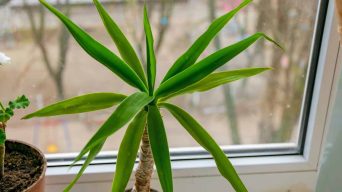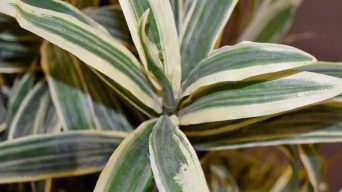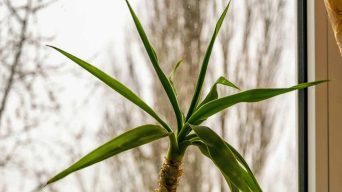Dracaena leaves droop due to underwatering, overwatering, insufficient light, low humidity, pests, temperature stress, or transplant shock. Addressing the specific cause—adjusting watering, light, humidity, temperature, or repotting—can revive the plant. Regular care and monitoring are key.
The Dracaena, renowned for its low maintenance and adaptability to various growing conditions, is a favorite among houseplant enthusiasts.
Despite their hardiness, a dracaena may sometimes encounter issues, such as drooping leaves.
Promptly identifying and addressing the cause of drooping is crucial for the health of your dracaena.
This article will explore seven typical reasons dracaena plants droop and corresponding solutions for each issue.
Drooping Dracaena Leaves: Key Reasons and Solutions
There are several reasons why your dracaena leaves might droop.
In most cases, drooping is caused by environmental stressors such as too much or too little water, insufficient light, or excessive heat.
However, there are other potential causes, including pests and transplant shock.
Read on to learn more about these potential causes and what you can do to fix the issue.
1. Underwatering
Underwatering is a frequent cause of dracaena plants to droop.
These houseplants, originating from tropical regions, thrive in moist, well-drained soils.
When the soil becomes too dry, the plant begins to wilt, leading to drooping.
It’s advisable to water your dracaena once a week or when the top inch of the soil feels dry.
Identifying Underwatering
Besides drooping leaves, look for these indicators of underwatering in a dracaena:
- Leaves that droop or wilt.
- Soil that feels dry to the touch.
- Leaves turning yellow.
- Edges of leaves browning and curling.
- Brittle leaves that break easily.
Reviving an Underwatered Dracaena
If your dracaena is underwatered, the best thing to do is to give it a good watering.
Water the plant thoroughly until water runs out of the drainage holes at the bottom of the pot.
Once the plant has been watered, regularly check the soil and water it when the top inch is dry.
2. Overwatering
Although drooping in dracaena houseplants are commonly associated with underwatering, overwatering can be just as problematic.
The Dracaena is particularly susceptible to excessive watering, leading to waterlogged conditions.
When the soil becomes too saturated, the root system begins to rot, resulting in a drooping dracaena.
Signs of Overwatering
Overwatering a dracaena manifests in several noticeable ways:
- Leaves turning yellow.
- Black spots on the leaves
- Wilting foliage.
- Excessively soggy or mushy soil.
- Mold or mildew presence on the soil’s surface.
- A foul odor emanating from the pot.
- Root rot.
Remedies for an Overwatered Dracaena
If your plant is overwatered, the best thing to do is to let the soil dry out completely.
Stop watering the plant and allow the top inch of soil to dry to the touch before watering it again.
If your plant’s roots are waterlogged, you may need to repot it in fresh soil.
Check the drainage holes at the bottom of the pot to make sure they are not blocked.
If the holes are blocked, water cannot drain correctly, and the roots will rot.
3. Insufficient Light
Dracaena needs bright, indirect light to thrive.
If your dracaena is not getting enough light, the foliage will droop.
Light requirements can vary depending on the type of dracaena you have.
For example, Dracaena marginata (dragon tree) needs bright light, while Dracaena fragrans (corn plant) can tolerate low light.
Detecting Light Deficiency
A dracaena struggling with insufficient light typically shows several symptoms:
- Leaves turn pale or yellow.
- Unusually small leaves.
- Sluggish growth, often leaning towards the light source.
These indicators can help identify and address light deficiency effectively.
Improving Light Conditions
The best way to fix a dracaena not getting enough light is to move it to a brighter location.
Dracaena needs at least 4 hours of indirect sunlight each day.
If possible, place the plant near a south- or west-facing window. This will give it the bright, indirect light it needs to thrive.
If you cannot move the plant to a brighter location, you may need to supplement the natural light with artificial lighting.
4. Low Humidity
Dracaenas thrive in high-humidity environments.
They thrive in rooms with an average humidity level of 60-70%.
The foliage will lose moisture and droop if the air around your dracaena is too dry.
Detecting Low Humidity Issues
When a dracaena lacks sufficient light, it exhibits several symptoms apart from drooping.
These include:
- Pale or yellow leaves
- Unusually small leaves
- Slowed growth rate
- The plant stretching towards the light source
These signs indicate the need for better lighting conditions to maintain the plant’s health.
Increasing Humidity Levels
There are several ways you can increase the humidity around your dracaena:
- Place the plant on a pebble tray: Fill a shallow dish with gravel and water. Place the dracaena on top of the gravel. The evaporating water will increase the humidity around the plant.
- Use a humidifier: Running a humidifier in the room where your dracaena is located will help to increase the humidity.
- Mist the leaves: Use a spray bottle to mist your dracaena with water. Do this once or twice a day.
5. Pests
Dracaena houseplants are susceptible to several pests, including spider mites, mealybugs, and scale insects.
Spider mites, tiny spider-like creatures, suck the sap out of the dracaena leaves, while mealybugs, small, white insects, also feed on the plant’s sap.
Scale insects, small and brown, attach themselves to the plant.
The presence of these pests can cause the dracaena to droop and eventually lead to leaf drop, significantly impacting the plant’s health.
Spotting Pest Infestations
A dracaena infested with pests often exhibits several telltale signs beyond the common symptom of drooping.
These include:
- Discoloration of leaves
- Blackening of leaves
- Wilted or curled leaves
- The presence of sticky sap on the plant
- Webbing on plant
Each indicator points towards potential pest problems and warrants further investigation and treatment.
Treating Pests on Dracaena
If you think your dracaena has pests, there are several things you can do to get rid of them:
- Remove the pests by hand: Use a cotton swab or cotton ball dipped in rubbing alcohol to remove the pests from the plant.
- Spray the plant with insecticidal soap: Mix 1 tablespoon of insecticidal soap with 1 quart of water. Spray the solution on the leaves and stems of the plant.
- Treat with neem oil: Neem oil is a natural pesticide that can be used to treat dracaena with pests. Mix 1 tablespoon of neem oil with 1 quart of water. Spray the solution on the plant.
6. Temperature Stress
The Dracaena is a tropical plant that prefers warm temperatures, and maintaining an adequate temperature range is important for its well-being.
They thrive in environments with an average temperature of 70-85 degrees Fahrenheit.
If the temperature around your dracaena drops below 60 degrees Fahrenheit, the plant’s foliage will start to droop.
Identifying Temperature Stress
Dracaena houseplants under temperature stress exhibit several symptoms beyond droop:
- Wilted or curled leaves
- Dry or brown tips
- Yellowing of leaves
- Slowed growth
Managing Temperature for Healthy Plants
If the temperature around your dracaena is too cold, there are several things you can do to fix the issue:
- Move the plant to a warmer location: If possible, move the houseplant to a room with an average temperature of 70-85 degrees Fahrenheit.
- Use a space heater: Place a space heater near the plant to increase the temperature.
- Cover the plant with a blanket: Use a light blanket or sheet to cover the plant. This will help to trap heat and create a microclimate around the plant.
7. Transplant Shock
The Dracaena can experience transplant shock when moved to a new pot or location.
This is because the plant’s roots are disturbed and cannot take up water and nutrients from the soil.
Transplant shock can cause the dracaena to droop.
Recognizing Transplant Shock Signs
Transplant shock in houseplants manifests through several distinct symptoms:
- Wilted or curled leaves
- Dry or brown leaves
- Slowed or stunted growth
These indicators, including the common droop, help in diagnosing transplant shock.
Easing Transplant Shock
If your dracaena is experiencing transplant shock, there are several things you can do to help it recover:
- Water the plant: Water the plant more frequently than usual to help it recover from transplant shock.
- Provide the plant with humidity: Increase the humidity around it by misting it with water or using a humidifier.
- Give the plant time: Transplant shock can be stressful for a dracaena, so giving the plant time to recover is essential.
Preventing Dracaena Leaf Drooping
Dracaena leaf drooping is a common problem. But don’t worry, you can do a few things to prevent them!
Here are 7 tips to keep your dracaena’s leaves perky:
1. Monitor Dracaena Soil Moisture
The first step is to check the soil moisture level.
If the soil is too dry, the dracaena will start to droop.
Stick your finger in the soil to see if it’s dry. If it feels dry, water your plant immediately.
2. Avoid Overwatering and Underwatering
Overwatering can result in root rot and other problems, whereas underwatering can cause a plant to wilt due to dryness.
Aim for a consistent watering schedule that keeps the soil moisture at the optimal level to keep your plants healthy.
Also, avoid tap water, as it may contain harmful chemicals or impurities that can damage your plants.
3. Ensure Good Drainage
Another potential cause of droop in dracaena is inadequate drainage.
If the water can’t drain properly, it will sit in the soil and make the roots waterlogged.
This can lead to root rot and, eventually, droopy foliage.
Ensure your plant is in a well-draining pot with holes in the bottom.
4. Avoid Waterlogging
After watering, drain any excess water from the saucer under the pot.
It’s important not to allow your plant to remain in water for extended periods, as this could cause root rot and foliage that begins to droop.
5. Optimize Dracaena Light Exposure
Dracaena needs bright, indirect light to thrive.
If the plant is in a too-dark spot, the leaves will start to droop.
Move it to a brighter spot and see if that helps.
But be careful not to place it in direct sunlight, as this can scorch the dracaena leaves.
6. Maintain Stable Temperatures
Dracaena doesn’t like sudden temperature changes.
So, if you’ve been keeping your dracaena outdoors and the temperature starts to drop, bring it inside.
Otherwise, the plant may start to droop.
7. Regularly Prune Dracaena Unhealthy Leaves
If your plants have dead or dying leaves, it’s best to prune them.
This will help encourage new growth and prevent the spread of disease.
Final Thoughts
Dracaena plants, renowned for their toughness, resilience, and straightforward dracaena care, usually thrive with minimal attention, making them ideal for indoor and outdoor settings.
However, if you notice your dracaena plant’s leaves drooping, it’s a sign to act, but there’s no need for alarm.
In most situations, resolving this is simple.
Start by checking the soil moisture level to ensure it’s not too dry or waterlogged. Good drainage is essential for successful gardening, so adjust if necessary.
Also, positioning your dracaena in a bright spot, but not in direct sunlight, is key.
By following these steps, you’ll likely see your dracaena perk up quickly, enhancing the beauty of your house or garden.







